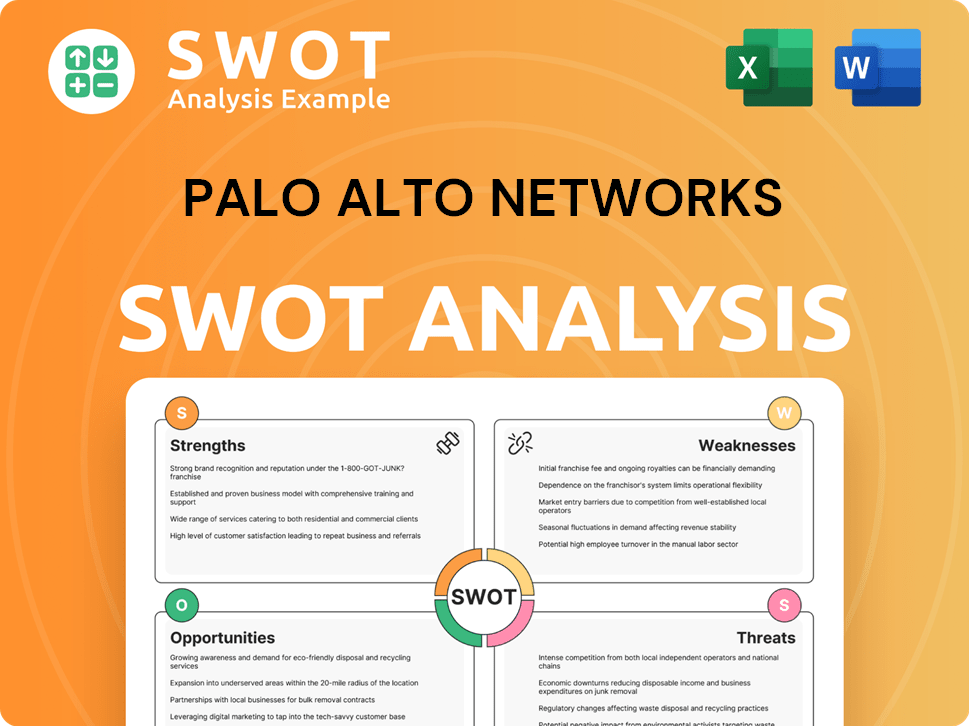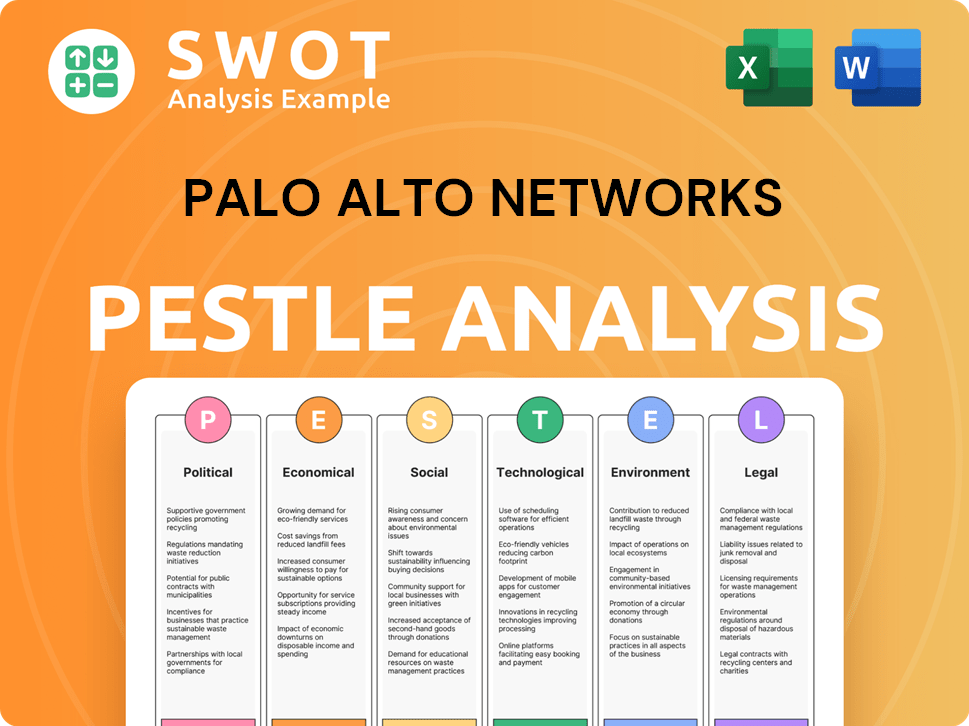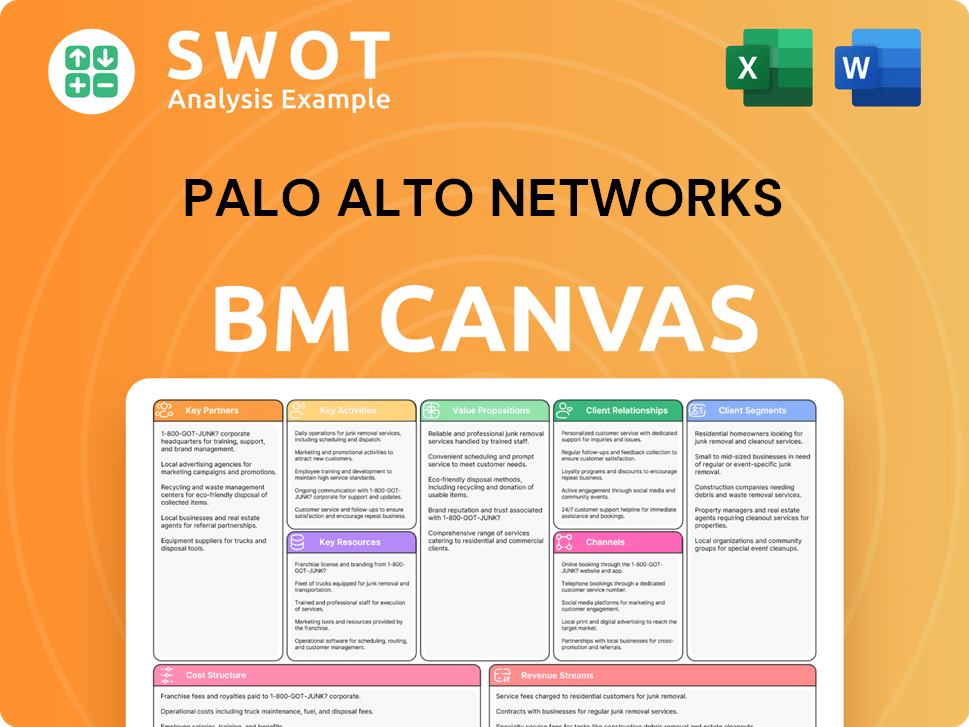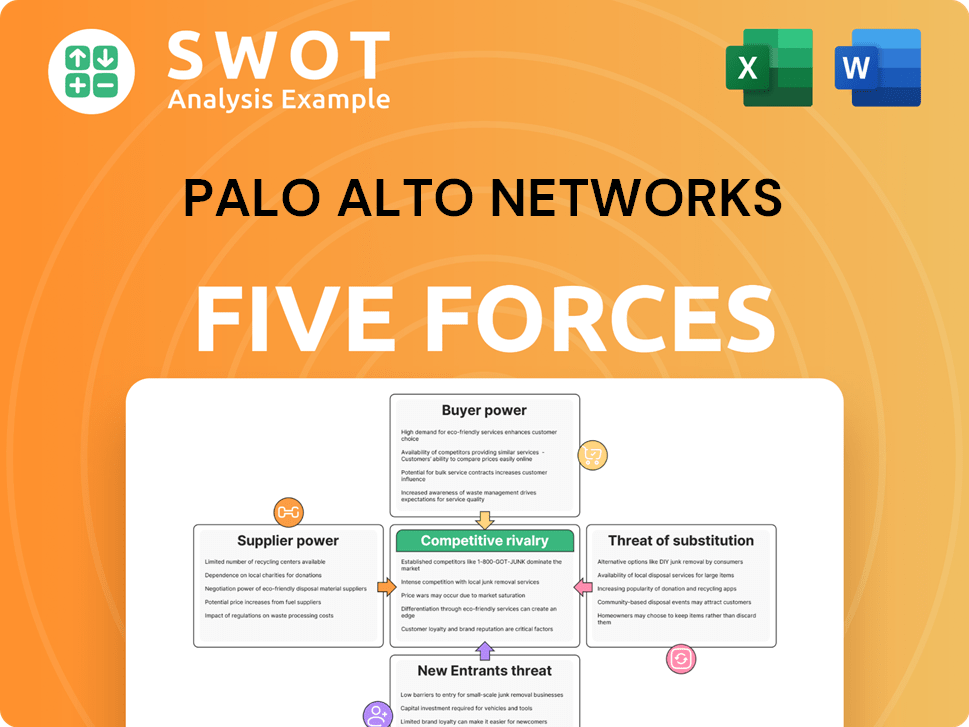Palo Alto Networks Bundle
Who's Challenging Palo Alto Networks in the Cybersecurity Arena?
The digital frontier is a battleground, and cybersecurity is the ultimate defense. Palo Alto Networks SWOT Analysis reveals the company's strengths, but who are its rivals in this high-stakes game? Understanding the competitive landscape is crucial for investors, strategists, and anyone navigating the complexities of the cybersecurity market.

This analysis dives deep into the Palo Alto Networks competition, providing a detailed cybersecurity market analysis. We'll explore the key network security vendors and their offerings, comparing their strengths and weaknesses. You'll gain insights into Palo Alto Networks' market share analysis, its competitive advantages, and how it stacks up against its top competitors like Cisco and Fortinet. This comprehensive overview will help you understand the current market trends and make informed decisions in the dynamic world of cybersecurity.
Where Does Palo Alto Networks’ Stand in the Current Market?
Palo Alto Networks maintains a strong market position within the cybersecurity industry. The company is a leader in network security and cloud security. It offers a comprehensive suite of products and services designed to protect organizations from cyber threats. This includes network firewalls, cloud security solutions, and security operations platforms.
The company caters to a diverse customer base, including large enterprises, government agencies, and small to medium-sized businesses. Its global presence is significant, with strong operations in North America, Europe, and the Asia-Pacific region. This wide reach allows it to serve a broad range of organizations across different geographies and industries.
The company's strategic shift from focusing on network firewalls to becoming a comprehensive cybersecurity platform provider reflects its response to the digital transformation initiatives of its customers and the increasing adoption of multi-cloud environments. This diversification has strengthened its market position and enabled it to offer integrated solutions that address the evolving security needs of modern organizations.
Palo Alto Networks is recognized as a leader in the cybersecurity market. It consistently ranks high in Gartner's Magic Quadrant for Network Firewalls and other key categories. The company's innovative approach and comprehensive security solutions have helped it gain a significant market share.
The company's product lines include Strata (network security), Prisma Cloud (cloud security), and Cortex (security operations). Strata provides advanced firewall capabilities, Prisma Cloud secures cloud environments, and Cortex offers security automation and threat intelligence. These offerings provide a comprehensive security posture for organizations.
Palo Alto Networks demonstrates robust financial health, which is crucial for sustained growth. The company reported revenue of approximately $2.04 billion in the third quarter of fiscal year 2024, marking a 15% year-over-year increase. This strong financial performance underscores its ability to invest in research and development.
The company has a significant global presence, with strong footholds in North America, Europe, and Asia-Pacific. This wide geographic reach allows it to serve a diverse customer base across different regions. Its global presence supports its ability to provide cybersecurity solutions worldwide.
Palo Alto Networks has strategically positioned itself to meet the evolving cybersecurity needs of its customers. Its focus on innovation and comprehensive solutions gives it a competitive edge. The company's ability to integrate various security functions into a unified platform is a key differentiator.
- Innovation: Continuous investment in R&D to stay ahead of emerging threats.
- Platform Approach: Integrated security platform that simplifies management.
- Customer Base: Wide range of customers, from SMBs to large enterprises.
- Threat Intelligence: Advanced threat intelligence capabilities for proactive security.
Palo Alto Networks SWOT Analysis
- Complete SWOT Breakdown
- Fully Customizable
- Editable in Excel & Word
- Professional Formatting
- Investor-Ready Format

Who Are the Main Competitors Challenging Palo Alto Networks?
Understanding the competitive landscape is crucial for evaluating any company, and for Palo Alto Networks, this involves a deep dive into its rivals across various cybersecurity segments. The company faces a dynamic environment where established players and emerging vendors constantly vie for market share. This analysis of the Palo Alto Networks competition will highlight key competitors and the strategies they employ.
The cybersecurity market is characterized by rapid innovation and constant evolution, making it essential to stay informed about the Palo Alto Networks competitors. This includes not only direct rivals but also indirect competitors and emerging technologies that could disrupt the market. Analyzing the competitive landscape provides insights into the strengths and weaknesses of each player, helping to understand the overall market dynamics and Palo Alto Networks' competitive advantages.
The competitive landscape Palo Alto Networks operates in is complex, with different players dominating in different segments. This chapter will break down the key competitors and their strategies, providing a comprehensive view of the market.
In network security, Palo Alto Networks competes with established vendors like Fortinet, Cisco, and Check Point Software Technologies. These companies offer a range of network security solutions, including firewalls, intrusion prevention systems, and VPNs.
Fortinet is a major competitor, known for its FortiGate firewalls and a broad portfolio of security solutions. They often compete on price and integrated services. In Q1 2024, Fortinet reported revenue of over $1.4 billion, demonstrating its strong market presence.
Cisco leverages its extensive networking infrastructure business and integrates security into its broader enterprise offerings. Cisco's security revenue in fiscal year 2023 was over $6 billion, highlighting its significant market share.
Check Point Software Technologies is a long-standing competitor in the firewall market, focusing on comprehensive threat prevention. Check Point's revenue in Q1 2024 was approximately $570 million, indicating a steady market position.
In the cloud security market, Palo Alto Networks' Prisma Cloud competes with companies like Zscaler, CrowdStrike, and Wiz. This segment is experiencing rapid growth due to the increasing adoption of cloud services.
Zscaler specializes in cloud-native security platforms, offering secure web gateways and zero trust network access. Zscaler's revenue for fiscal year 2023 was over $1.6 billion, reflecting its strong position in the cloud security market. For more information about the company's target market, you can read more on the Target Market of Palo Alto Networks.
Beyond the main competitors, the cybersecurity market is dynamic, with emerging players and specialized vendors continually disrupting the landscape. Mergers and acquisitions also play a significant role in reshaping the competitive environment.
- CrowdStrike: A leader in endpoint protection and cloud workload protection. CrowdStrike's annual recurring revenue (ARR) grew to over $3 billion in fiscal year 2024.
- Wiz: Focuses on cloud security posture management. Wiz has rapidly gained market share, attracting significant investment.
- SD-WAN and OT Security: Emerging players in software-defined wide area network (SD-WAN) security and operational technology (OT) security are also becoming increasingly relevant.
- Mergers and Acquisitions: Acquisitions, such as Broadcom's acquisition of VMware's security assets, consolidate market power and alter product portfolios.
Palo Alto Networks PESTLE Analysis
- Covers All 6 PESTLE Categories
- No Research Needed – Save Hours of Work
- Built by Experts, Trusted by Consultants
- Instant Download, Ready to Use
- 100% Editable, Fully Customizable

What Gives Palo Alto Networks a Competitive Edge Over Its Rivals?
Understanding the competitive landscape for security providers is crucial for investors and businesses alike. This analysis focuses on the competitive advantages of a leading cybersecurity firm, examining its strengths and how they position it within the industry. The objective is to provide a clear view of its market position and how it differentiates itself from the competition.
This firm has consistently demonstrated its ability to adapt and innovate, evolving from a next-generation firewall provider to a comprehensive security platform. This evolution reflects its commitment to meeting the changing demands of the cybersecurity market. The company's strategic moves and technological advancements are key to understanding its competitive edge.
The company's integrated platform approach is a significant advantage, unifying network security, cloud security, and security operations. This integration allows for better threat visibility and simplified management, reducing the complexity often associated with managing disparate security solutions. This integrated approach is a key differentiator in the cybersecurity market.
The company's integrated platform unifies network security, cloud security, and security operations. This provides better threat visibility and simplified management. Customers benefit from reduced complexity compared to managing multiple point solutions.
The company utilizes proprietary technologies, such as a single-pass inspection engine. These technologies offer superior threat prevention capabilities and faster detection of advanced attacks. This leads to stronger security for customers.
The company has a strong brand reputation for innovation and advanced security features. Industry analysts and customers consistently recognize its ability to address evolving cyber threats. This reputation fosters strong customer loyalty.
The company has a global distribution network and strategic partnerships with MSSPs. These partnerships enhance market reach and the ability to serve diverse customer needs. This broad reach is crucial for market penetration.
The company's competitive advantages include its integrated platform, proprietary technologies, brand equity, and extensive distribution network. These factors contribute to its strong market position and ability to compete effectively. Understanding these advantages is crucial for assessing its long-term prospects and Owners & Shareholders of Palo Alto Networks.
- Integrated Platform: Unifies network, cloud, and security operations.
- Advanced Threat Prevention: Superior capabilities and faster detection.
- Strong Brand Reputation: Recognized for innovation and advanced features.
- Global Reach: Extensive distribution and strategic partnerships.
Palo Alto Networks Business Model Canvas
- Complete 9-Block Business Model Canvas
- Effortlessly Communicate Your Business Strategy
- Investor-Ready BMC Format
- 100% Editable and Customizable
- Clear and Structured Layout

What Industry Trends Are Reshaping Palo Alto Networks’s Competitive Landscape?
Understanding the competitive landscape for Palo Alto Networks involves analyzing industry trends, future challenges, and opportunities. The company faces a dynamic environment shaped by evolving cybersecurity threats, technological advancements, and market demands. A thorough examination of these factors provides insights into Palo Alto Networks' strategic positioning and potential for growth.
The cybersecurity market is experiencing significant shifts, impacting all players, including Palo Alto Networks. These shifts are driven by the increasing adoption of cloud computing, the rise of remote work, and the growing sophistication of cyberattacks. Therefore, a deep dive into these aspects is essential for understanding the company's prospects and challenges.
The cybersecurity industry is influenced by the expansion of cloud computing, hybrid work models, and stringent regulatory changes. Cloud security solutions and Secure Access Service Edge (SASE) architectures are in high demand. Cyberattacks are becoming more sophisticated, requiring continuous innovation in threat detection and prevention. These trends impact the entire competitive landscape for companies like Palo Alto Networks.
Palo Alto Networks faces challenges from increasing competition, particularly from cloud-native security providers. The cybersecurity talent shortage also adds pressure, increasing the demand for automated security operations. Adapting to rapid technological changes and maintaining a competitive edge requires significant investment and strategic agility. These challenges are key in the Palo Alto Networks competition analysis.
The growing need for consolidated security platforms, like SASE and Extended Detection and Response (XDR), aligns with Palo Alto Networks' integrated platform strategy. Expansion into emerging markets, strategic acquisitions, and continued investment in AI and ML offer growth avenues. The company's focus on platform consolidation and AI-driven security is crucial for capitalizing on market demands.
Palo Alto Networks is concentrating on platform consolidation and AI-driven security to maintain its competitive position. The company aims to provide comprehensive security solutions that address evolving threats and customer needs. This strategic approach is vital for long-term success in the cybersecurity market, as highlighted in the Marketing Strategy of Palo Alto Networks.
Palo Alto Networks operates in a dynamic cybersecurity market, shaped by significant trends and challenges. The company's ability to capitalize on opportunities will determine its future success. Key factors include platform consolidation, AI-driven security, and strategic market expansion.
- Market Growth: The global cybersecurity market is projected to reach approximately $345.7 billion in 2024, growing to $467.7 billion by 2029.
- Cloud Security: The cloud security market is expected to grow significantly, with a projected value of $90.7 billion by 2029.
- Competitive Landscape: Key competitors include Cisco, Fortinet, and Zscaler, each with their own strengths and strategies.
- Strategic Acquisitions: Palo Alto Networks has made strategic acquisitions to enhance its product offerings and market position.
Palo Alto Networks Porter's Five Forces Analysis
- Covers All 5 Competitive Forces in Detail
- Structured for Consultants, Students, and Founders
- 100% Editable in Microsoft Word & Excel
- Instant Digital Download – Use Immediately
- Compatible with Mac & PC – Fully Unlocked

Related Blogs
- What are Mission Vision & Core Values of Palo Alto Networks Company?
- What is Growth Strategy and Future Prospects of Palo Alto Networks Company?
- How Does Palo Alto Networks Company Work?
- What is Sales and Marketing Strategy of Palo Alto Networks Company?
- What is Brief History of Palo Alto Networks Company?
- Who Owns Palo Alto Networks Company?
- What is Customer Demographics and Target Market of Palo Alto Networks Company?
Disclaimer
All information, articles, and product details provided on this website are for general informational and educational purposes only. We do not claim any ownership over, nor do we intend to infringe upon, any trademarks, copyrights, logos, brand names, or other intellectual property mentioned or depicted on this site. Such intellectual property remains the property of its respective owners, and any references here are made solely for identification or informational purposes, without implying any affiliation, endorsement, or partnership.
We make no representations or warranties, express or implied, regarding the accuracy, completeness, or suitability of any content or products presented. Nothing on this website should be construed as legal, tax, investment, financial, medical, or other professional advice. In addition, no part of this site—including articles or product references—constitutes a solicitation, recommendation, endorsement, advertisement, or offer to buy or sell any securities, franchises, or other financial instruments, particularly in jurisdictions where such activity would be unlawful.
All content is of a general nature and may not address the specific circumstances of any individual or entity. It is not a substitute for professional advice or services. Any actions you take based on the information provided here are strictly at your own risk. You accept full responsibility for any decisions or outcomes arising from your use of this website and agree to release us from any liability in connection with your use of, or reliance upon, the content or products found herein.